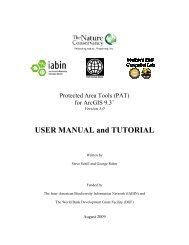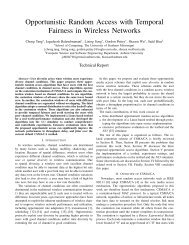The Drawl - Southern Miss Alumni Association
The Drawl - Southern Miss Alumni Association
The Drawl - Southern Miss Alumni Association
Create successful ePaper yourself
Turn your PDF publications into a flip-book with our unique Google optimized e-Paper software.
Campus in Long Beach. In 2007, the <strong>Miss</strong>issippi Institutions of Higher<br />
Learning committed to a new <strong>Southern</strong> <strong>Miss</strong> campus, Cross Creek, on the<br />
I-10 corridor in west Harrison County.<br />
As plans emerge for the institution’s future all along the Gulf Coast, the<br />
<strong>Southern</strong> <strong>Miss</strong> community remembers that Monday in August 2005 when<br />
Katrina hit. <strong>The</strong> University of <strong>Southern</strong> <strong>Miss</strong>issippi remains firmly committed<br />
to the people of the <strong>Miss</strong>issippi Gulf Coast.<br />
Kennard, who died in 1963, collecting more than 1,500 signatures in<br />
support of a governor’s pardon. A pardon was not required, however, as<br />
Forrest County Circuit Court Judge Bob Helfrich threw out Kennard’s<br />
original burglary conviction, stating, “To me, this is not a black and white<br />
issue; it’s a right and wrong issue. To correct that wrong, I am compelled to<br />
do the right thing.”<br />
Cross Creek Campus<br />
In April 2007, the State Board of Trustees of Institutions for Higher<br />
Learning announced that the Cross Creek Development just north of Long<br />
Beach near I-10 would be the site of a new <strong>Southern</strong> <strong>Miss</strong> campus.<br />
<strong>The</strong> <strong>Southern</strong> <strong>Miss</strong> Gulf Coast campus will be part of a larger 1,800-acre<br />
development. Hancock Bank and Gulf South Technology Center, LLC, owners<br />
of the Cross Creek Development, donated the property for the campus.<br />
<strong>The</strong> new 200-acre site will be developed as <strong>Southern</strong> <strong>Miss</strong> Gulf Coast’s central<br />
campus, while the University’s Gulf Park Campus in Long Beach will<br />
continue to be used for stand-alone programs.<br />
African-American<br />
History<br />
In September 1965, <strong>Southern</strong> <strong>Miss</strong> enrolled<br />
its first African-American students, Raylawni<br />
Branch and Gwendolyn Elaine Armstrong.<br />
Since that time, the school has seen an enormous<br />
increase in African-American<br />
enrollment and takes great pride in the diversity<br />
of its student body. In 1969, Dr. Walter<br />
Washington was the first African-American<br />
to earn a doctoral degree from <strong>Southern</strong> <strong>Miss</strong> or from any <strong>Miss</strong>issippi institution<br />
of higher learning. In 1974, Fred Cook was selected as the<br />
University’s first African-American Mr. USM, and in 1980, Jacqueline Redd<br />
became the University’s first African-American Homecoming queen.<br />
In February 1993, <strong>Southern</strong> <strong>Miss</strong> held “A Celebration of Diversity,” during<br />
which time the contributions of African-American faculty, staff and<br />
students were honored. At that time, the Student Services Building was<br />
renamed Kennard-Washington Hall, in honor of Dr. Walter Washington<br />
(then president of Alcorn State University in Lorman, <strong>Miss</strong>.) and Clyde<br />
Kennard, an African-American who was denied admission to <strong>Miss</strong>issippi<br />
<strong>Southern</strong> College during the 1950s. <strong>The</strong> February University Forum lecture<br />
was named the Armstrong-Branch African-American History Month lecture.<br />
In recent years, an effort to clear the name of Kennard mounted, as it<br />
became apparent that he had served prison time on false charges of theft.<br />
African-American students from the University joined the fight for<br />
Prominent Buildings and Features<br />
Ori g i n a l Bu i l d i n g s (all designed by architect R.H. Hunt of<br />
Chattanooga, Tenn., and built in 1912)<br />
• College Hall: College Hall was the original school building. It housed all<br />
classrooms, administrative offices, a library and the auditorium. Its current<br />
use is for classrooms and offices.<br />
• Forrest County Hall: Built as a residence hall for men and married students,<br />
the building is named for Forrest County, which, in conjunction with<br />
the city of Hattiesburg, provided funds for building the school. It currently<br />
houses business offices.<br />
• Hattiesburg Hall: Built as a residence hall for women, the building was<br />
named for the city of Hattiesburg in honor of its role in providing funds to<br />
build the school. <strong>The</strong> building continues to function as a residence hall.<br />
• <strong>The</strong> Honor House: Originally called the Industrial Cottage, the purpose<br />
of the building was to provide a laboratory for girls to “learn practical homekeeping<br />
in all its phases.” Since then, the two-story brick structure has<br />
served as the campus clinic, a dormitory and faculty housing; it currently<br />
houses the <strong>Southern</strong> <strong>Miss</strong> Foundation.<br />
<strong>The</strong> name Honor House came about in 1957 when the building housed<br />
upperclass and graduate female students who lived there “on their honor.”<br />
34 <strong>The</strong> <strong>Drawl</strong> – Centennial Edition w w w . s o u t h e r n m i s s a l u m n i . c o m 35

















